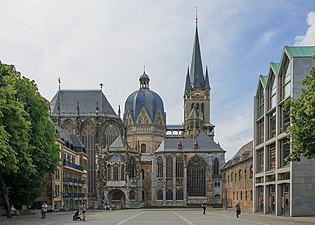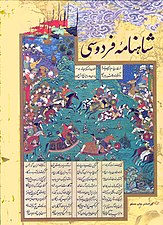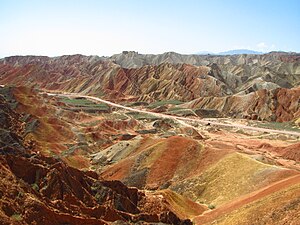UNESCO cultural and natural heritage
The UNESCO cultural and natural heritage includes cultural assets and natural landscapes that are protected by UNESCO according to one of its conventions or one of its programs.
overview
Starting with the World Heritage Convention of 1972, UNESCO has initiated various conventions and programs with which the cultural and natural heritage of mankind is to be protected and preserved. However, this is not to be understood in terms of museum conservation. The German UNESCO Commission (DUK) writes:
“UNESCO world heritage sites, biosphere reserves, geoparks, forms of intangible cultural heritage and world document heritage are testimonies to history and a basis for the creation of a peaceful future. Preserving them, using them for intercultural dialogue and global partnerships and shaping the future with them is the central concern of UNESCO. As the only organization in the world, it combines the preservation of important cultural and natural heritage and global commons with sustainable development and contemporary artistic and cultural forms of expression. "
Individual conventions and programs
The most famous designated by UNESCO as a cultural and natural heritage properties are in accordance with the World Heritage Convention of 1972 in the list of UNESCO world heritage recognized sites of the UNESCO world heritage . This was preceded by the Hague Convention for the Protection of Cultural Property in the Event of Armed Conflict of 1954 and the UNESCO Convention on Measures to Prohibit and Prevent the Illegal Import, Export and Transfer of Ownership of Cultural Property of 1970.
In the 21st century, other conventions and programs related to the protection of cultural and natural heritage were adopted. These include the Convention for the Protection of the Underwater Cultural Heritage , the Convention for the Conservation of the Intangible Cultural Heritage and the Convention for the Protection of Cultural Diversity .
The Biosphere Reserves are based on the program Man and the Biosphere (Man and the Biosphere, MAB), the UNESCO Global Geoparks on the program International Geoscience and Geopark and the World Soundtrack Awards on the program memory of the world (Memory of the World, MOW).
Also to be mentioned are the Ramsar Convention , the Washington Convention on the Conservation of Species , the Bonn Convention , the United Nations Convention on the Law of the Sea , the Convention on Biological Diversity , the 1995 Rome Unidroit Convention on stolen or illegally exported cultural goods and the United Nations Framework Convention on Climate Change .
Various UNESCO bodies or intergovernmental organizations decide on changes to the UNESCO cultural and natural heritage.
World heritage
The UNESCO World Heritage includes the sites of world cultural and natural heritage that have been recognized and entered on the World Heritage List by the UNESCO World Heritage Committee on the basis of the Convention for the Protection of the World Cultural and Natural Heritage, which was adopted in 1972 and entered into force in 1975 . As of January 2017, 193 states have ratified or acceded to this convention. 183 of these states have submitted a tentative list (proposal list) to UNESCO , in which potential candidates for the world heritage are entered. Each state may nominate a maximum of two sites per year from this list for inclusion in the World Heritage List. The World Heritage Committee then decides at its annual meeting on admission, postponement or rejection.
The UNESCO World Heritage Committee consists of representatives from 21 of the countries that have acceded to the World Heritage Convention. It has held an ordinary meeting every year since 1977, with extraordinary meetings being held if necessary. It will decide whether to accept, postpone or reject the proposals nominated for the respective session that have previously been assessed by ICOMOS (for cultural heritage) or by the IUCN (for natural heritage). In addition, status reports on individual World Heritage sites are checked at these meetings and a decision is made as to which sites are to be placed on the Red List of World Heritage in Danger or removed from it. Very rarely, entire World Heritage sites or individual components have been deleted from the World Heritage List.
In 1978 the World Heritage List was opened with 12 world cultural and natural heritage sites, including Aachen Cathedral and Yellowstone National Park . As of July 2018, 1092 World Heritage sites from 167 countries are registered on the World Heritage List, including 845 cultural heritage sites, 209 natural heritage sites and 38 mixed natural and cultural heritage sites. 37 of these sites are cross-border or transnational , i.e. assigned to two or more states. World Heritage sites whose existence is endangered are included in the Red List of World Heritage in Danger. As of July 2018, 54 sites are registered there. Two world heritage sites have so far been removed from the world heritage list .
Intangible cultural heritage
Intangible cultural heritage includes cultural expressions such as B. dance, theater, music, languages, handicraft techniques, oral traditions, customs and festivals, which are crucially supported by human knowledge and ability, are passed on from generation to generation and can also be changed in the process. In contrast to the immovable world heritage sites or the movable objects of the world document heritage, they are not material and therefore cannot be touched.
The Convention for the Conservation of Intangible Cultural Heritage was adopted in 2003 and entered into force in 2006. As of June 2016, 172 states had ratified the convention. UNESCO maintains three lists for intangible cultural heritage (entries as of 2016): the representative list of the intangible cultural heritage of mankind (365 entries), the list of the intangible cultural heritage in urgent need of conservation (47 entries) and the register of good practice examples (17 entries) for model Projects to protect and strengthen intangible cultural heritage. In addition, each country keeps national lists of its intangible cultural heritage, which, however, are not part of the UNESCO intangible cultural heritage. An intergovernmental committee for the preservation of the intangible cultural heritage decides at its annual meetings after a detailed evaluation of the nominated intangible cultural objects by an advisory and subcommittee on their inclusion in one of the three lists of the intangible cultural heritage.
As part of its forerunner program Masterpieces of Oral and Intangible Cultural Heritage , launched in 1997 , UNESCO recognized a total of 90 particularly valuable intangible cultural assets in 2001, 2003 and 2005, which were officially transferred to the Representative List in 2008.
Underwater cultural heritage
The underwater cultural heritage includes evidence of human culture that has been underwater for more than 100 years and is of historical or cultural importance. These include u. a. Shipwrecks and their contents as well as sunken cities or other cultural sites. Underwater cultural heritage is protected by the Convention for the Protection of Underwater Cultural Heritage , which was adopted in 2001 and came into force in 2009. As of 2016, 56 states had ratified the convention.
The Convention does not place specific individual cultural assets under special protection, but rather contains general principles of protection for underwater cultural heritage, for example the prohibition of any trade in artifacts from shipwrecks that are more than 100 years old. This is to prevent looting of underwater cultural assets. The convention also defines guidelines for underwater archeology .
World document heritage
The world document heritage includes selected outstanding documents, including books, manuscripts, scores, unique pieces, image, sound and film documents. As part of its Memory of the World (MOW) program, founded in 1992 for the preservation of the documentary heritage of mankind, UNESCO maintains a list of the documents it has recognized as world document heritage.
Every two years, each state can nominate a maximum of two documents for inclusion in the directory. The Director General of the UNESCO Secretariat decides on the inclusion of documents in the World Document Heritage after the nominations have been examined by an International Advisory Committee appointed by him. As of 2017, the World Document Heritage List contains 427 documents from 107 countries.
Biosphere reserves
Biosphere reserves are model regions from the UNESCO program Man and the Biosphere (MaB, Mensch und Biosphere), in which the harmonious coexistence of man and nature is to be promoted.
The International Coordination Council of the UNESCO Program “Man and the Biosphere” (MAB) decides on the recognition of biosphere reserves initially designated under state law as UNESCO biosphere reserves. As of 2016 there are 651 of these biosphere reserves worldwide.
Global Geoparks
UNESCO Global Geoparks from the UNESCO International Geoscience and Geoparks program are landscapes and geological sites of international geoscientific importance. They are united in the Global Geoparks Network .
The UNESCO Executive Council decides on the sites proposed by the UNESCO Global Geoparks Council . As of April 2018, there are 140 UNESCO Global Geoparks in 38 countries.
Web links
![]() Wikipedia: WikiProjekt UNESCO-Kultur- und -naturerbe - Wikipedia internal specialist editorial office on the topic UNESCO culture and natural heritage
Wikipedia: WikiProjekt UNESCO-Kultur- und -naturerbe - Wikipedia internal specialist editorial office on the topic UNESCO culture and natural heritage
- Cultural and natural heritage on the website of the German Commission for UNESCO with links to the individual projects
World heritage:
- World Heritage on the World Heritage Center website
- World Heritage on the website of the German Commission for UNESCO
- The UNESCO World Heritage on the website of the Austrian Commission for UNESCO
- World Heritage on the website of the Swiss Commission for UNESCO
Intangible cultural heritage:
- Intangible Heritage on the UNESCO website
- Intangible cultural heritage on the website of the German Commission for UNESCO
- Intangible cultural heritage on the website of the Austrian Commission for UNESCO
- Intangible cultural heritage on the website of the Swiss Commission for UNESCO
Underwater cultural heritage:
- Underwater Cultural Heritage on the UNESCO website
- Cultural heritage under water on the website of the German Commission for UNESCO
World document heritage:
- Memory of the World on the UNESCO website
- Memory of mankind on the website of the German Commission for UNESCO
- World Document Heritage - Memory of the World on the website of the Austrian Commission for UNESCO
- Memory of mankind on the website of the Swiss Commission for UNESCO
Biosphere Reserves:
- Man and the Biosphere Program on the UNESCO website
- Biosphere reserves on the website of the German Commission for UNESCO
- Man and the Biosphere (MAB) on the website of the Austrian Commission for UNESCO
- People and the biosphere on the website of the Swiss Commission for UNESCO
UNESCO Global Geoparks:
- UNESCO Global Geoparks on the UNESCO website
- UNESCO Global Geoparks on the website of the German UNESCO Commission
Individual evidence
- ↑ Culture and Nature. In: unesco.de. German UNESCO Commission, accessed on July 15, 2020 .
- ↑ Convention for the Protection of the World’s Cultural and Natural Heritage of November 16, 1972 (German version)
- ↑ Cornelia Gersch: Cultural property in danger - robbery excavations and illegal trade. Conference report ed. by the Prussian Cultural Heritage Foundation , as of July 30, 2015
- ↑ cf. UNESCO Center for the World Heritage: Guidelines for the Implementation of the Convention for the Protection of the World Cultural and Natural Heritage Final version of June 2, 2017, No. 44, p. 14 f.
- ^ World Heritage List. In: whc.unesco.org. UNESCO World Heritage Center, accessed August 6, 2018 .
- ↑ Document heritage . Accessed March 8, 2018 (German).
- ↑ Robert Fischer , Natalie Göltenboth, Eckhard Schuster, Marcus Würmli: Das Erbe der Welt 2012/2013. The cultural and natural monuments of the world according to the convention of UNESCO. Large special chapter: UNESCO's document heritage . Kunth-Verlag, Munich 2012, ISBN 978-3-89944-902-0
- ↑ 13 Sites in Africa, Asia, Europe and North America Receive UNESCO Global Geopark Label. In: News on en.unesco.org. UNESCO, April 17, 2018, accessed April 18, 2018 .






























